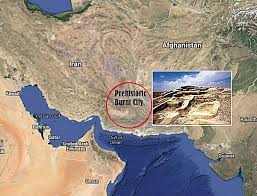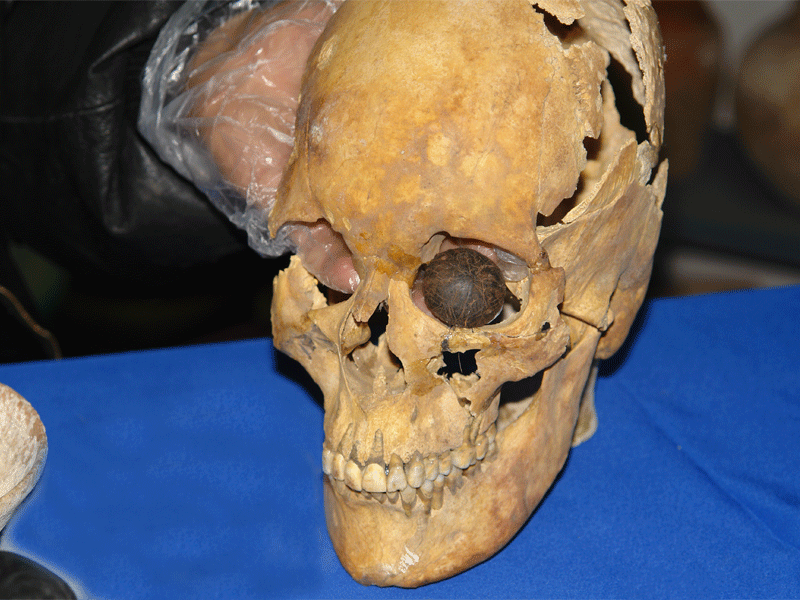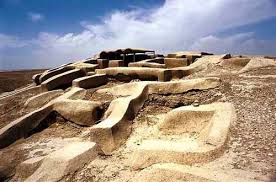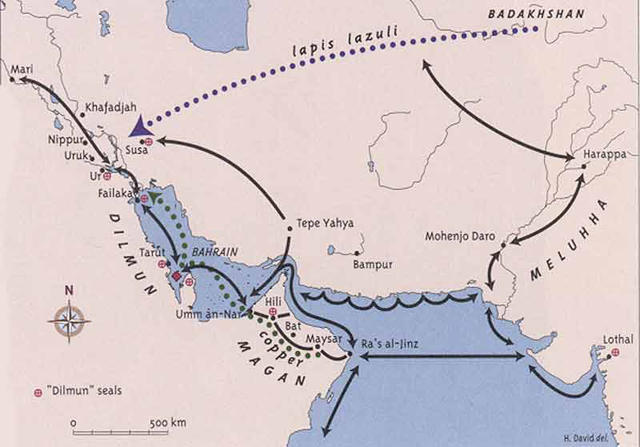It looks like you're using an Ad Blocker.
Please white-list or disable AboveTopSecret.com in your ad-blocking tool.
Thank you.
Some features of ATS will be disabled while you continue to use an ad-blocker.
share:
Shahr-e Sukhteh in South Eastern Iran is known as the Burnt City. It was founded around 3200 BC and burned down three times before being abandoned in
1800BC.

A recent discovery of a piece of leather covered in drawings add to the mystery of this special place. Archaeologists are trying to save this rare find before it deteriorates.
Excavations have revealed some other amazing discoveries including an artificial eyeball, a 10cm ruler allegedly accurate to 1mm and a marble cup with completely unknown decorations.

Below is shown an example of pottery featuring the world’s oldest known example of animation, also excavated from the site.


The findings have led some to conclude that a unique culture arose independently from their Mesopotamian neighbours:

The Burnt City covers 373 acres, and is one of the largest sites from a time when people were beginning to settle in urban landscapes. Containing over 25,000 graves, it gives a glimpse into how populated this ancient city really was and how our perception of this era is very, very wrong.
For more, read:
www.abovetopsecret.com...
en.wikipedia.org...
www.ancient-origins.net...
www.iranreview.org...

A recent discovery of a piece of leather covered in drawings add to the mystery of this special place. Archaeologists are trying to save this rare find before it deteriorates.
Excavations have revealed some other amazing discoveries including an artificial eyeball, a 10cm ruler allegedly accurate to 1mm and a marble cup with completely unknown decorations.
(The eyeball) ... has a hemispherical form and a diameter of just over 2.5 cm (1 inch). It consists of very light material, probably bitumen paste. The surface of the artificial eye is covered with a thin layer of gold, engraved with a central circle (representing the iris) and gold lines patterned like sun rays. The female remains found with the artificial eye was 1.82 m tall (6 feet), much taller than ordinary women of her time. On both sides of the eye are drilled tiny holes, through which a golden thread could hold the eyeball in place. Since microscopic research has shown that the eye socket showed clear imprints of the golden thread, the eyeball must have been worn during her lifetime. The woman's skeleton has been dated to between 2900 and 2800 BCE.[13]

Below is shown an example of pottery featuring the world’s oldest known example of animation, also excavated from the site.


The findings have led some to conclude that a unique culture arose independently from their Mesopotamian neighbours:
“Ancient Mesopotamia, corresponding to modern-day Iraq, Kuwait and north eastern Iran, is widely considered to be the cradle of western civilization,” New Historian’s Adam Steedman Thake writes.
“If it is the case that the Burnt City had developed free from Mesopotamian influence, it could mean that the early urban era was a lot more metropolitan than previously thought. If Mesopotamia was simply one of many city-based civilizations from 5,000 years ago, we will need to rethink the origins of our urban living.”
(Bolding mine)

Recent excavations also uncovered ruins of a structure in an urban part of the Burnt City. The structure has two walls, each about a yard (1 meter) thick and is supported by nine buttresses.
“The signs of fire are clearly seen in some rooms of the building,” Sajjadi said. The team had found a small adjoining room in the building. The room had pieces of colored (sic) and plain textiles. The smaller chamber may have been used as a place for conducting sacrifices, scholars speculate, and the textiles may have contained offerings.
The Burnt City covers 373 acres, and is one of the largest sites from a time when people were beginning to settle in urban landscapes. Containing over 25,000 graves, it gives a glimpse into how populated this ancient city really was and how our perception of this era is very, very wrong.
For more, read:
www.abovetopsecret.com...
en.wikipedia.org...
www.ancient-origins.net...
www.iranreview.org...
From Wikipedia link
Really interesting thanks for sharing
Other objects found at the site include a human skull which indicates the practice of brain surgery
Really interesting thanks for sharing
a reply to: beansidhe
It doesn't really challenge anything it's already well known that Mesopotamian culture by 5,200 years ago was in trade contact with other cultures at similar levels of advancement in Iran and the Indus Valley, even through colonies they had established in Dilmun and Magan

The founding of Uruk still pre-dates this by some 800 years.
It doesn't really challenge anything it's already well known that Mesopotamian culture by 5,200 years ago was in trade contact with other cultures at similar levels of advancement in Iran and the Indus Valley, even through colonies they had established in Dilmun and Magan

The founding of Uruk still pre-dates this by some 800 years.
Uruk gave its name to the Uruk period, the protohistoric Chalcolithic to Early Bronze Age period in the history of Mesopotamia spanning c. 4000 to 3100 BC, succeeded by the Jemdet Nasr period of Sumer proper
a reply to: Kantzveldt
Hi Kantzveldt,
When I say 'challenges our perception' read layman, like myself! What interested me asides from the brain surgery, prosthetic eyeball, backgammon boards etc was the scale of this place. When we (ok, I) read about Mesopotamian trade, I don't think of them trading with sprawling urban cities. It offers a view of a very urban landscape, something that is often missing from my understanding of that era. If Steedman Thake is correct, should we expect more mega-cities further east, and how far will they stretch? From where do they originate?
All fascinating questions, good to see you by the way.
Hi Kantzveldt,
When I say 'challenges our perception' read layman, like myself! What interested me asides from the brain surgery, prosthetic eyeball, backgammon boards etc was the scale of this place. When we (ok, I) read about Mesopotamian trade, I don't think of them trading with sprawling urban cities. It offers a view of a very urban landscape, something that is often missing from my understanding of that era. If Steedman Thake is correct, should we expect more mega-cities further east, and how far will they stretch? From where do they originate?
All fascinating questions, good to see you by the way.
edit on 21-1-2015 by beansidhe because: punc
a reply to: beansidhe
The initial direction seems to be from further North West, there are cities being discovered, or at least they were, in Northern Syria also having been established around 6,000 years ago such as Hamoukar, not so surprising as Northern Syria and Anatolia were the epi-centre of the Neolithic period which had begun there thousands of years previously, no subsequent advancement was ever truly independent.
The initial direction seems to be from further North West, there are cities being discovered, or at least they were, in Northern Syria also having been established around 6,000 years ago such as Hamoukar, not so surprising as Northern Syria and Anatolia were the epi-centre of the Neolithic period which had begun there thousands of years previously, no subsequent advancement was ever truly independent.
a reply to: Kantzveldt
I really, really want to see a picture of the marble cup with its 'unknown decoration' but as it was only discovered in December there, there's nothing on the internet yet.
If that claim is true, that it doesn't seem to have come from Mesopotamian culture, then should we look to Anatolia (Gobekli Tepe) for it's origins or somewhere else? I can't wait to see it!
I really, really want to see a picture of the marble cup with its 'unknown decoration' but as it was only discovered in December there, there's nothing on the internet yet.
If that claim is true, that it doesn't seem to have come from Mesopotamian culture, then should we look to Anatolia (Gobekli Tepe) for it's origins or somewhere else? I can't wait to see it!
a reply to: strongfp
That's a really good point, strongfp, thanks for dropping by.
It is known to have been razed and rebuilt 3 times, in part or in entirety I don't know, which might suggest that the geography was important for food, farming, trade etc. It could have been built upon something even older, which is a really exciting thought.
I would make a crap archaeologist, I'm far too impatient. Found a couple of jars? Great, lets get a JCB in and go deeper!
That's a really good point, strongfp, thanks for dropping by.
It is known to have been razed and rebuilt 3 times, in part or in entirety I don't know, which might suggest that the geography was important for food, farming, trade etc. It could have been built upon something even older, which is a really exciting thought.
I would make a crap archaeologist, I'm far too impatient. Found a couple of jars? Great, lets get a JCB in and go deeper!
a reply to: NwFgHr
Hi there!
Backgammon and prosthetic eyes, painted leather - it feels modern and urban...well, to an extent! Finds like these help me to feel more connected to the past, as if a bit of dirt on a grimy window is being wiped away, piece by tiny piece.
I can't find anything which explains why it was burnt, but maybe another of the members knows. I could guess at raiders or war, or maybe a new reign who demanded everything to be clean and new but other than that, I'm at a loss.
Glad you enjoyed it too
Hi there!
Backgammon and prosthetic eyes, painted leather - it feels modern and urban...well, to an extent! Finds like these help me to feel more connected to the past, as if a bit of dirt on a grimy window is being wiped away, piece by tiny piece.
I can't find anything which explains why it was burnt, but maybe another of the members knows. I could guess at raiders or war, or maybe a new reign who demanded everything to be clean and new but other than that, I'm at a loss.
Glad you enjoyed it too
a reply to: beansidhe
Great post Beansidhe. It's long been known the Sumerians arrived at the flood plains of the Euphrates and Tigris from a region to their north east, closer to Iran than modern Iraq. The ancient peoples of Uruk and Eridu only [i[just eked out a claim as the 'first' civilization, as there were a lot of other contenders that were poised to do the same soon after. Although, most of those were seen as advancing with trade contact with Mesopotamia - I suppose that is the point of this article, that this city in Iran shows a great degree of independent advancement from their western neighbors.
As to why the 'Burnt City' was burned down so many times before abandonment, it appears to have had little in the way of defensive walls. No doubt it was continually overrun and sacked. When Sumerians began settling in Mesopotamia they faced the same conditions, constant threats from the 'wild people,' and built cities with defensive walls - Kramer notes having the ability to defend their land was a contributing factor in the rise of the first city-states in the Ubaid and Uruk periods - Uruk alone had a wall as high as 50 feet (15M). Uruk survived, the 'Burnt City' did not...
Great post Beansidhe. It's long been known the Sumerians arrived at the flood plains of the Euphrates and Tigris from a region to their north east, closer to Iran than modern Iraq. The ancient peoples of Uruk and Eridu only [i[just eked out a claim as the 'first' civilization, as there were a lot of other contenders that were poised to do the same soon after. Although, most of those were seen as advancing with trade contact with Mesopotamia - I suppose that is the point of this article, that this city in Iran shows a great degree of independent advancement from their western neighbors.
As to why the 'Burnt City' was burned down so many times before abandonment, it appears to have had little in the way of defensive walls. No doubt it was continually overrun and sacked. When Sumerians began settling in Mesopotamia they faced the same conditions, constant threats from the 'wild people,' and built cities with defensive walls - Kramer notes having the ability to defend their land was a contributing factor in the rise of the first city-states in the Ubaid and Uruk periods - Uruk alone had a wall as high as 50 feet (15M). Uruk survived, the 'Burnt City' did not...
i am interested in the ruler.
So they found a 5000 year old ruler that had a nearly perfect representation of the metric system?
So they found a 5000 year old ruler that had a nearly perfect representation of the metric system?
a reply to: beansidhe
Great interesting thread. Think you hit it on the head when you made the point about being connected to the past - or indeed our past.
Everything 'official' seems to have been focused back to around 2000 years ago and things going back before that time was for many, odd lessons most of us yawned through at school when we were probably too young to understand the implications of older civilisations, or is in the realms of an arbitrary scholastic reticence to correct our current views of history and rewrite it based on today's knowledge.
The fact part of that city had been burned could be due to a number of things - accidental fires in a dangerous part of the city, civil war, invasions etc etc but the one that gets me is the eyeball for the female with the gold threads and her actual height. I seem to remember there was the remains of a race of people found in China who were tall and blond. I do hope we can get some dna evidence from the bones at the city to learn more about their origins.
You are right about how the painted leather and things that make us realise how like them we are. I suspect there are a lot of remains that are simply far deeper under ground that we haven't a clue about because its such a tantalising gap between when we first started on this planet up to the Egyptians, Indians and mesopotaneans etc etc
Great interesting thread. Think you hit it on the head when you made the point about being connected to the past - or indeed our past.
Everything 'official' seems to have been focused back to around 2000 years ago and things going back before that time was for many, odd lessons most of us yawned through at school when we were probably too young to understand the implications of older civilisations, or is in the realms of an arbitrary scholastic reticence to correct our current views of history and rewrite it based on today's knowledge.
The fact part of that city had been burned could be due to a number of things - accidental fires in a dangerous part of the city, civil war, invasions etc etc but the one that gets me is the eyeball for the female with the gold threads and her actual height. I seem to remember there was the remains of a race of people found in China who were tall and blond. I do hope we can get some dna evidence from the bones at the city to learn more about their origins.
You are right about how the painted leather and things that make us realise how like them we are. I suspect there are a lot of remains that are simply far deeper under ground that we haven't a clue about because its such a tantalising gap between when we first started on this planet up to the Egyptians, Indians and mesopotaneans etc etc
new topics
-
Ireland VS Globalists
Social Issues and Civil Unrest: 1 minutes ago -
Biden "Happy To Debate Trump"
Mainstream News: 32 minutes ago -
RAAF airbase in Roswell, New Mexico is on fire
Aliens and UFOs: 41 minutes ago -
What is the white pill?
Philosophy and Metaphysics: 2 hours ago -
Mike Pinder The Moody Blues R.I.P.
Music: 2 hours ago -
Putin, Russia and the Great Architects of the Universe
ATS Skunk Works: 6 hours ago -
A Warning to America: 25 Ways the US is Being Destroyed
New World Order: 10 hours ago
top topics
-
President BIDEN's FBI Raided Donald Trump's Florida Home for OBAMA-NORTH KOREA Documents.
Political Conspiracies: 16 hours ago, 34 flags -
A Warning to America: 25 Ways the US is Being Destroyed
New World Order: 10 hours ago, 18 flags -
Mike Pinder The Moody Blues R.I.P.
Music: 2 hours ago, 7 flags -
What is the white pill?
Philosophy and Metaphysics: 2 hours ago, 5 flags -
RAAF airbase in Roswell, New Mexico is on fire
Aliens and UFOs: 41 minutes ago, 4 flags -
Is AI Better Than the Hollywood Elite?
Movies: 17 hours ago, 4 flags -
Biden "Happy To Debate Trump"
Mainstream News: 32 minutes ago, 3 flags -
Putin, Russia and the Great Architects of the Universe
ATS Skunk Works: 6 hours ago, 2 flags -
Maestro Benedetto
Literature: 17 hours ago, 1 flags -
Ireland VS Globalists
Social Issues and Civil Unrest: 1 minutes ago, 0 flags
active topics
-
Gaza Terrorists Attack US Humanitarian Pier During Construction
Middle East Issues • 80 • : Asher47 -
Ireland VS Globalists
Social Issues and Civil Unrest • 0 • : TimBurr -
Biden "Happy To Debate Trump"
Mainstream News • 6 • : KrustyKrab -
New whistleblower Jason Sands speaks on Twitter Spaces last night.
Aliens and UFOs • 73 • : pianopraze -
Meadows, Giuliani Among 11 Indicted in Arizona in Latest 2020 Election Subversion Case
Mainstream News • 27 • : IndieA -
RAAF airbase in Roswell, New Mexico is on fire
Aliens and UFOs • 3 • : Degradation33 -
University of Texas Instantly Shuts Down Anti Israel Protests
Education and Media • 277 • : Threadbarer -
What is the white pill?
Philosophy and Metaphysics • 14 • : kwaka -
Las Vegas UFO Spotting Teen Traumatized by Demon Creature in Backyard
Aliens and UFOs • 16 • : introufo2 -
Post A Funny (T&C Friendly) Pic Part IV: The LOL awakens!
General Chit Chat • 7136 • : underpass61
